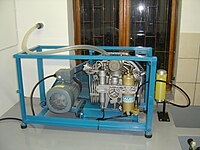
Photo from wikipedia
Abstract The vapor compression system is the dominant technology in providing cooling and heating for residential, commercial, and industrial applications, and thus has significant energy and environmental impact. To predict… Click to show full abstract
Abstract The vapor compression system is the dominant technology in providing cooling and heating for residential, commercial, and industrial applications, and thus has significant energy and environmental impact. To predict the steady-state performance of vapor compression systems with a wide variety of configurations and operating modes, a general-purpose representation and solution methodology for vapor compression systems was developed using a component-based simulation architecture. The proposed methodology uses mass flow sign propagation to determine the working fluid flow directions. A tripartite-graph based tearing method was applied to reveal the most efficient component execution order, and to identify the corresponding tearing variables and residual equations. The resulting equations are solved using quasi-Newton method. The representation and solution methods are applied to six test systems: five R410A systems and one CO2 system, with capacities ranging from 10 to 100 kW. The test systems were chosen to represent a wide range of HVAC applications and operating modes, including residential heat pump, dual-circuit chiller, vapor injection system, supermarket system, and VRF system. The steady-state solutions of the test systems were verified and/or validated against existing simulations and experimental data. The observed worst case simulation energy imbalance across all cases was 0.91%, and the maximum system performance deviation was 8.94% compared to existing data.
Journal Title: Applied Thermal Engineering
Year Published: 2020
Link to full text (if available)
Share on Social Media: Sign Up to like & get
recommendations!